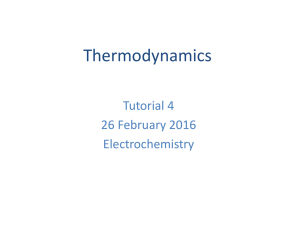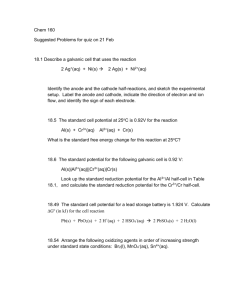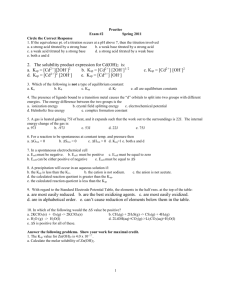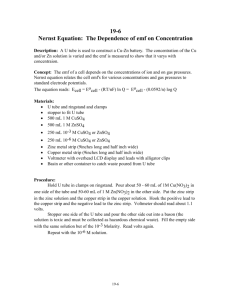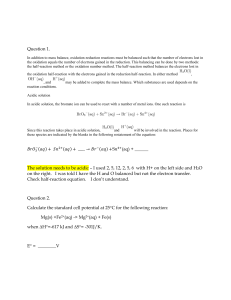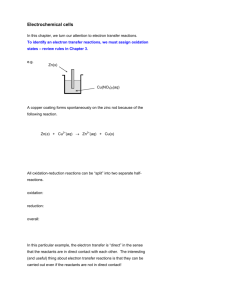In Part II, we are going to look at diagramming, line notations, and
advertisement
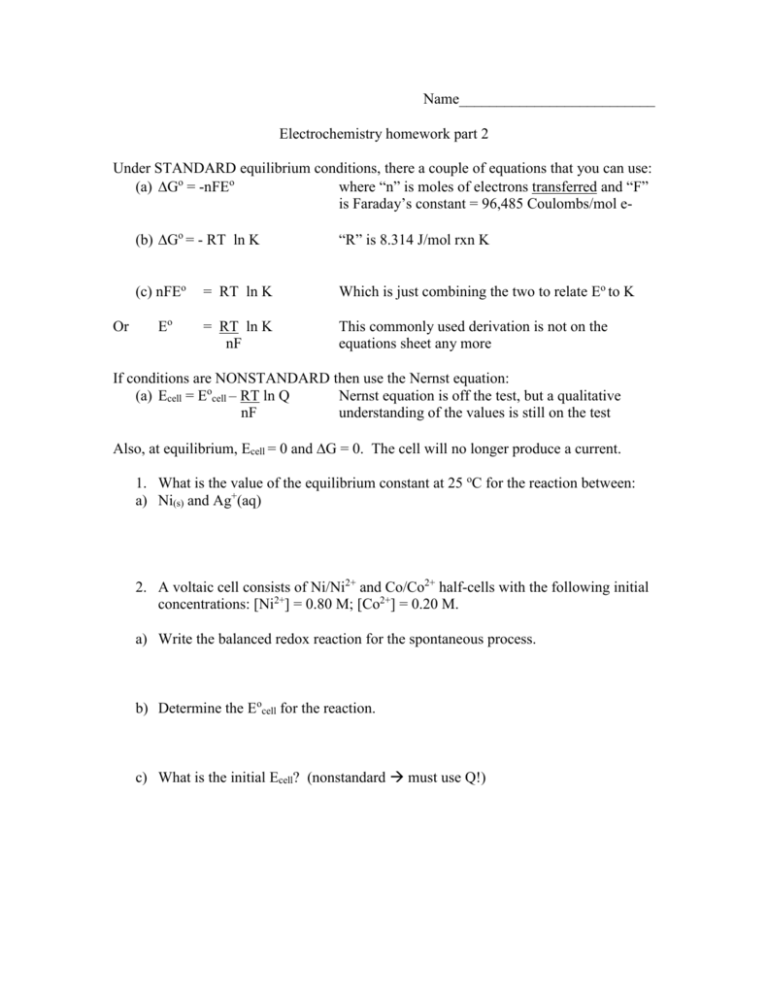
Name__________________________ Electrochemistry homework part 2 Under STANDARD equilibrium conditions, there a couple of equations that you can use: (a) Go = -nFEo where “n” is moles of electrons transferred and “F” is Faraday’s constant = 96,485 Coulombs/mol e- Or (b) Go = - RT ln K “R” is 8.314 J/mol rxn K (c) nFEo = RT ln K Which is just combining the two to relate Eo to K Eo = RT ln K nF This commonly used derivation is not on the equations sheet any more If conditions are NONSTANDARD then use the Nernst equation: (a) Ecell = Eocell – RT ln Q Nernst equation is off the test, but a qualitative nF understanding of the values is still on the test Also, at equilibrium, Ecell = 0 and G = 0. The cell will no longer produce a current. 1. What is the value of the equilibrium constant at 25 oC for the reaction between: a) Ni(s) and Ag+(aq) 2. A voltaic cell consists of Ni/Ni2+ and Co/Co2+ half-cells with the following initial concentrations: [Ni2+] = 0.80 M; [Co2+] = 0.20 M. a) Write the balanced redox reaction for the spontaneous process. b) Determine the Eocell for the reaction. c) What is the initial Ecell? (nonstandard must use Q!) d) What is the Ecell when [Co2+] = 0.45 M? Hint: If [Co2+] increased, then [Ni2+] must have decrease by a stoichiometric amount. e) What is the [Ni2+] when Ecell = 0.025 V? Solve for the “Q” ratio to determine the change in “x.” You’ll get the concentration subtracting “x” from the initial concentration. f) What are the equilibrium concentrations of the ions? In this case, Ecell = 0, so use the right equation. Solve the “K” ratio to determine the change in “x.” You’ll get the concentrations by adding and subtracting “x” from the initial concentrations. The last topic is electrolysis. This process is nonspontaneous. We can, however, make the reaction work if an external power source is supplied. The main thing you need to be able to do here is the stoichiometry involved with electrolysis. You should be methodical, writing out every unit possible to get the desired result. The following are useful conversion factors that you should know: a) 1 Ampere = 1 Coulomb/ second b) 1 Volt = 1 Joule/Coulomb c) 1 F = 96500 Coulombs/mol eSome other helpful hints: a) You will need the # mol e- transferred in the balanced redox reaction. b) You may be asked to solve for the molar mass of an unknown metal. Molar mass = gram / mole 3. How many grams of potassium can be deposited by the passage of 315 C through an electrolytic cell? 4. How long in seconds does it take to deposit 15.5 g Zn on a steel gate when 25.0 A are passed through a ZnSO4 solution? 5. Electrolysis of molten metal (MCl3) using a current of 6.50 A for 1397 seconds deposits 1.41 g of the metal at the cathode. What is the metal? (Hint: based on the chemical formula, the metal has a 3+ charge, inferring that 3 electrons were transferred.) 6. In an electrolytic cell, a current of 0.250 ampere is passed through a solution of a chloride of iron, producing Fe(s) and Cl2(g). a) Write the equation for the reaction that occurs at the anode. b) When the cell operates for 2.00 hours, 0.521 grams of iron is deposited at one electrode. Determine the formula of the chloride of iron in the original solution. c) Write the balanced equation for the overall reaction that occurs in the cell. 7. Sr(s) + Mg2+(aq) Sr2+(aq) + Mg(s) Consider the reaction represented above that occurs at 25 oC. All reactants and products are in their standard states. The value of the equilibrium constant, Keq, for the reaction is 4.2 x 1017 at 25 oC. (a) Predict the sign of the standard cell potential, Eocell, for a cell based on the reaction. Explain your prediction. Do not look at a table to get your answer. (b) Identify the oxidizing agent for the spontaneous reaction. (c) If the reaction were carried out at 60 oC instead of 25 oC, how would the cell potential change? Justify your answer. (d) How would the cell potential change if the reaction were carried out at 25 oC with a 1.0 M solution Mg(NO3)2 and 0.10 M solution of Sr(NO3)2? Explain. (e) When the cell reaction in (d) reaches equilibrium, what is the cell potential? 8. Answer the following questions that refer to the galvanic cell shown in the diagram above. (a) Identify the anode of the cell and write the half-reaction that occurs there. (b) Write the net ionic equation for the overall reaction that occurs as the cell operates and calculate the value of the standard cell potential, Eocell. (c) Indicate how the value of Ecell would be affected if the concentration of Ni(NO3)2(aq) was changed from 1.0 M to 0.10 M and the concentration of Zn(NO3)2(aq) remained 1.0 M. Justify your answer. (d) Specify whether the value of Keq for the cell reaction is less than 1, greater than 1, or equal to 1. Justify your answer. 9. Answer the following questions regarding the electrochemical cell shown to the lowerright. (a) Write the balanced net-ionic equation for the spontaneous reaction that occurs as the cell operates, and determine the cell voltage. (b) In which direction do anions flow in the salt bridge as the cell operates. Justify your answer. (c) If 10.0 mL of 3.0 M AgNO3 solution is added to the half-cell on the right, what will happen to the cell voltage? Explain. (d) If 1.0 grams of solid NaCl is added to each half-cell, what will happen to the cell voltage? Explain. (e) If 20.0 mL of distilled water is added to both half-cells, the cell voltage decreases. Explain. 10. Answer the following questions that relate to electrochemical reactions. (a) Under standard conditions at 25 oC, Zn(s) reacts with Co2+(aq) to produce Co(s). (i) Write the balanced equation for the oxidation half-reaction. (ii) Write the balanced net-ionic equation for the overall reaction. (iii) Calculate the standard cell potential, Eo, for the overall reaction at 25 o C. (b) At 25 oC, H2O2 decomposes according to the following equation. 2H2O2(aq) 2H2O(l) + O2(g) Eo = 0.55 V (i) Determine the value of the standard free energy change, Go, for the reaction at 25 oC. (ii) Determine the value of the equilibrium constant, Keq, for the reaction at 25 oC. (iii) The standard reduction potential, Eo, for the half-reaction O2(g) + 4H+(aq) + 4e- 2H2O(l) has the value of 1.23 V. Using the information in addition to the information given above, determine the value of the standard reduction potential, Eo, in the half-reaction below. O2(g) + 2H+(aq) + 2e- H2O2(aq) (c) In an electrochemical cell, Cu(s) is produced by the electrolysis of CuSO4 (aq). Calculate the maximum mass of Cu(s) that can be deposited by a direct current of 100. amperes passed through 5.00 L of 2.00 M CuSO4(aq) for a period of 1.00 hour.

